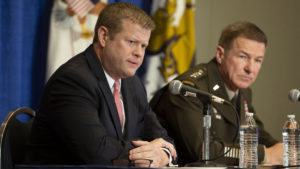Facing potential tighter budgets in the coming years, the Army will look at assessing readiness requirements to save funds along with its “borderline contentious” divestiture decisions in the near future, the service’s secretary said Wednesday.
“The Army, we’re always there. We’re in Detroit or we’re in Baghdad. We’re everywhere. Now, we’re trying to put some left and right limits to that because we have to bring on all these new weapon systems. We make $40 billion of investments a year, we have to make sure we get the maximum yield of these dollars,” Secretary Ryan McCarthy said during a virtual Hudson Institute discussion.

McCarthy noted the Army currently has 27 brigades at the highest level of readiness, and may look at where tweaks can be made to determine “how ready do you have to be” and where funds can be saved.
“This institution is pressed…and it has been for the last 19 years. Our people are tired. So we need to find the right balance between the two, there’s opportunities there,” McCarthy said.
McCarthy reiterated the service will continue its “night court” process to shift funds from low priorities to modernization efforts, while noting that upcoming divestiture decisions will get tougher in the next few years.
“We’re going to have to continue to start first with divestitures. We’ve done a lot, and I think the challenges that will be in front of us will be you’re going to be looking at weapon systems that might be in the [Modified Table of Organization and Equipment]. These will be tougher cuts. At times, these will be borderline contentious because they’ve been around for awhile,” McCarthy said.
The Army’s FY ‘21 budget request included plans to cut, reduce or delay 80 programs to realign another $13.5 billion toward modernization over the next five years per the latest round of “night court,” which follows last year’s review resulting in adjustment to 186 program to find $33 billion.
McCarthy has previously discussed his view that the Army will require three to five percent topline growth to meet modernization initiatives and avoid a “collision course,” as well as considering potentially reducing its end strength to realign resources (Defense Daily, March 4).